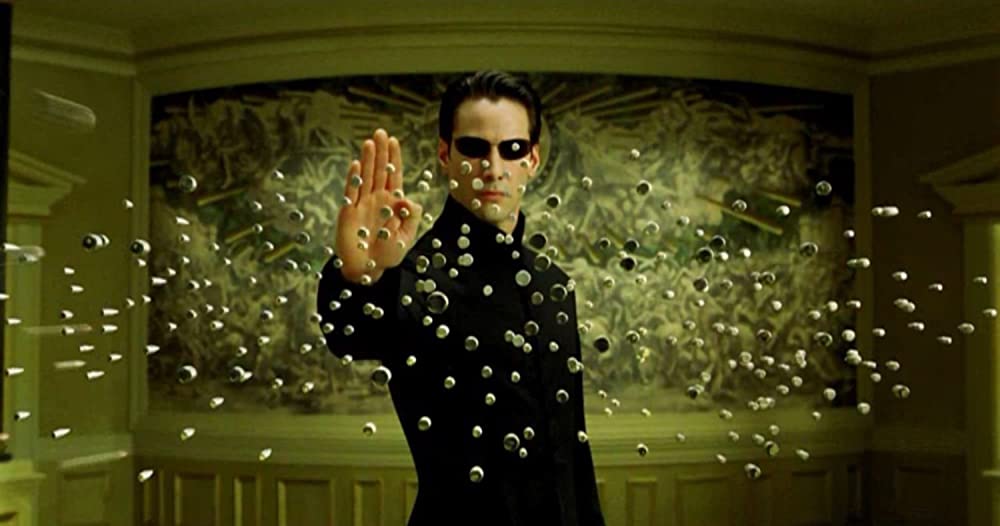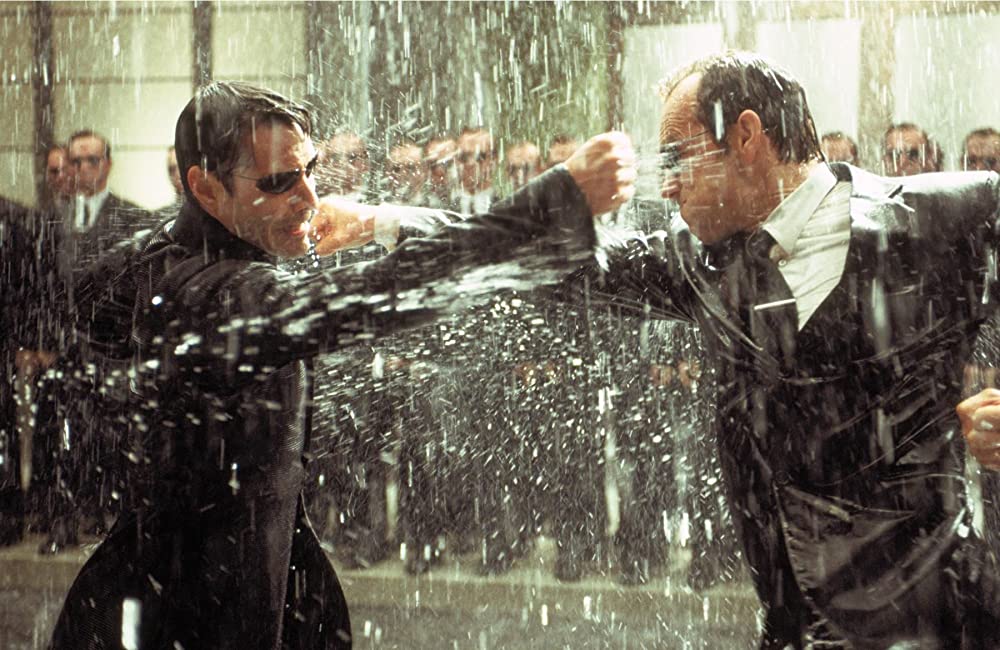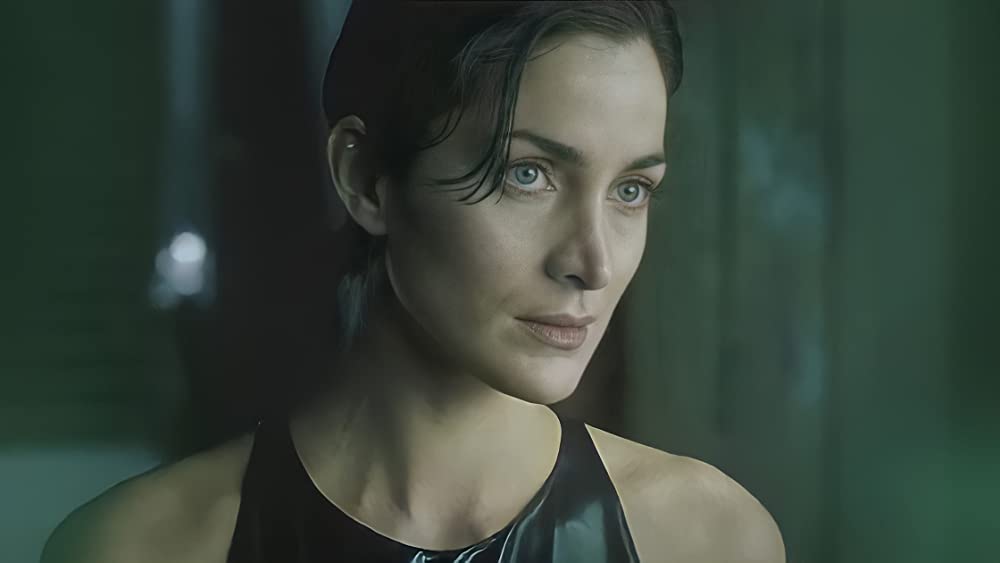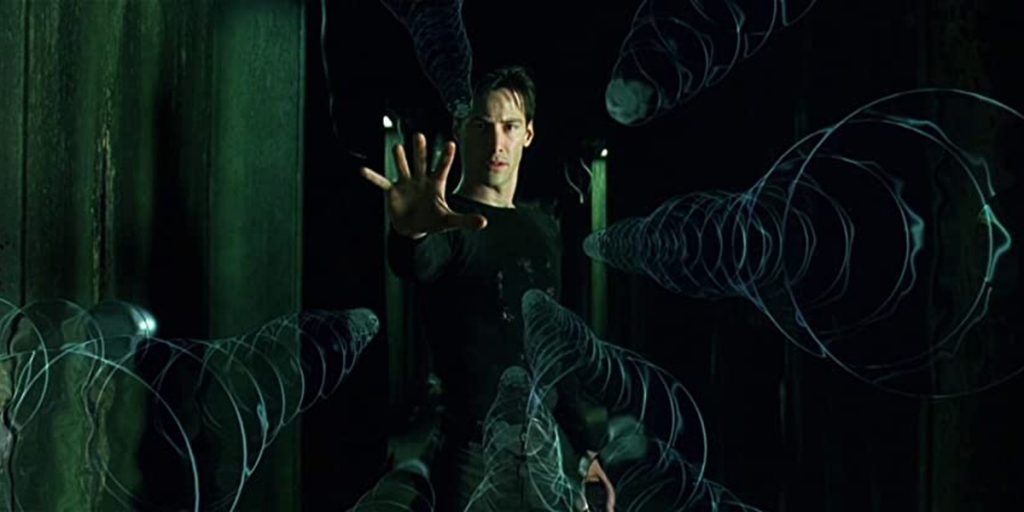Leading up to release of The Matrix Resurrections, we’re taking a look back at the original Matrix trilogy to see how it holds up.
When you think about The Matrix trilogy, what’s the first thing that pops into your head? Perhaps it’s a disappointment to you, after the brilliant first entry in 1999 was followed by two sequels in 2003 that weren’t as highly praised by fans and critics alike. Maybe you hold it up there with the Lord of The Rings trilogy and the first three Star Wars films as a work of cinematic excellence. In all honesty, I’m not sure what to think of it, even today. I had a Neo action figure that I probably shouldn’t have had as a kid in 2003, because I thought it looked cool, but I didn’t actually see the trilogy until I was a teenager. Back then, I was very much in the camp that “The first one is great, but the sequels sucked”. As a result of that mindset, I haven’t gone back and watched any of the Matrix films in full in the years since, despite being a fan of series star Keanu Reeves.
With The Matrix Resurrections set to release in theaters and on HBO Max on December 22nd, I decided, for the first time in years, to return to the world created by Lana and Lilly Wachowski. Yes, The Matrix (1999) is widely considered by many, including myself, to be a masterpiece. Its use of fight choreographers and wire fu techniques from Hong Kong action cinema influenced plenty of Hollywood’s big budget action films in the decades that followed. The effects, including the famous “Bullet time” sequence, are groundbreaking, and the film went on to win the Oscar for Best Visual Effects at the 72nd Academy Awards. That award was one of four Oscars won by The Matrix, which was and still is a cultural phenomenon. However, its sequels, The Matrix Reloaded and The Matrix Revolutions, which were filmed back-to-back and released mere months apart in 2003, received mixed receptions compared to the widespread acclaim of the first entry.
Why is it that I’ve never felt like revisiting these films in all these years? And what is my impression of these films, watching them again now? Those questions, along with the impending release of the fourth film, are what inspired me not only to watch The Matrix trilogy for the first time in 8 years or so, but also to write this retrospective for Loud and Clear. There’s certainly no harm in giving these films another shot, and watching them again could answer some of the questions I have about 2021’s The Matrix Resurrections, after watching the trailer, and will probably get me more excited for that film. While you and I wait for the next chapter, let’s journey back down the rabbit hole, and see what we think of The Matrix trilogy after all this time.
THE MATRIX (1999)

The Matrix centers on Thomas Anderson, also known as Neo (Keanu Reeves), a computer programmer/hacker who uncovers the true nature of reality, and is drawn into a rebellion against intelligent machines. Despite the fact that the film has been referenced and/or parodied to death in the years since its release, it’s still an incredible cinematic achievement. The Wachowskis crafted a world that is so unique. Their fascinating world building will draw you in, presenting new and interesting concepts all while playing out this big picture mystery of “What is The Matrix?”. Even though I knew what was going to happen when I rewatched the film, I was still very drawn to that mystery. The exact moment I was drawn in would have to be when we first meet Neo, and someone beckons him to “Follow the white rabbit” using his computer screen. It’s a simple moment, but it’s the one that sets everything in motion. I, like Neo, was now asking questions about what “The Matrix” is, and going on this journey with him. This world is a visual spectacle from the opening moments, and you’re instantly asking questions about what is going on. You’re transported into this cyberpunk-like world that has a slight green tint to it, and there’s a woman at a computer that’s on the phone with someone. This woman is being chased not only by police, but also a group in black suits and sunglasses. That’s all before she proceeds to perform some kung fu moves on the officers and escape after being chased by the men in black suits. If you’re watching The Matrix for the first time, this opening sequence will leave you with more questions than answers. Then, the directors build this world around strong characters like Neo, the mysteriously cool Morpheus (Laurence Fishburne), and the ultra badass Trinity (Carrie-Anne Moss), two humans that have been freed from The Matrix, and are part of a rebellion against intelligent machines.
The characters and world work together to create a story that is unlike anything you’ve ever seen. It’s a story that pushes the bounds of reality and makes you wonder just how much of it is fiction. Can anyone truly say for sure that we aren’t living in some sort of simulation? Pushing that boundary is what makes the story of The Matrix special, with its intricate worldbuilding helping to blur the lines between reality and fiction. If that isn’t enough for you, the story, world, and characters are complimented by some of the most epic action sequences and special effects of all time. I’m not joking when I say that the final half hour of The Matrix is perhaps the greatest climax in cinematic history. There’s so much action, including solid hand to hand combat, and groundbreaking effects. It’s such a rush, and when the film finally ends in badass fashion with a battle between Neo and Agent Smith (Hugo Weaving), a sentient program designed to keep humans from leaving The Matrix, you’ll cheer.
Speaking of Smith, the computer program that can jump from body to body makes for a compelling antagonist. He’s emotionless, like you’d expect a machine to be, but he’s also calculating and ruthless when it comes to executing his primary directive. That ruthlessness, along with Weaving’s pitch perfect performance that makes you question if the actor himself is more machine than man, creates an amazing villain. His opposition, Neo, is played by Keanu Reeves in a role that helped relaunch his career. Reeves is able to perfectly capture the fish out of water nature of Neo and his more badass side. Considering he underwent surgery on his neck prior to pre-production, the fact that Reeves was able to train and film the action scenes is a massive feat. The casual viewer likely won’t even know he was still recovering from the surgery during filming because of how well he nails the fight sequences.
When it comes to the original Matrix film, I’m not sure why I hadn’t watched it in years. I suppose that my mind told me that I couldn’t just watch one film without watching the sequels. The reality is that The Matrix stands pretty well on its own, even though there is an open ending. That, again, speaks to the quality of the story told: it’s tightly written, but it does leave the door open for more. When you watch the film for the first time, you’ll love the story and action. If you give it a second watch, you’ll take note of the technical aspects, such as the score by Don Davis, which is something that I didn’t pay much attention to originally. The score’s combination of different elements, including synthesizer elements, is quite pleasing to the ears.
THE MATRIX RELOADED (2003)

The Matrix Reloaded picks up months after the events of the first film, with Neo, Morpheus, and Trinity now living in the city of Zion and leading the human resistance against the machines. When Zion comes under siege, the trio must again return to The Matrix in an attempt to save the human race from extinction. The movie sounds pretty interesting based on my synopsis, right? Unfortunately, while this is an accurate description of the film, what actually transpires isn’t as cool or as good as it could be.
Unlike its predecessor, The Matrix Reloaded has a story that really drags. Yes, The Matrix had its fair share of explosion, but all of it helped to build the world that The Wachowskis were creating. It also had a slick, tight, quick story that never felt boring. The sequel, on the other hand, has a few interesting developments that are spread out over two hours. The exposition is endless – that is, unless there is a fight sequence. This makes Reloaded feel quite bloated, despite it being only a few minutes longer than The Matrix. While I can pay better attention to the exposition than I did as a teenager, it honestly doesn’t make it any easier to watch. Things pick up in the second hour, which better resembles the original film, before it gets bogged down again. I can clearly understand why I have avoided watching this again: despite some stellar action sequences, and the fact that I do like these characters, it’s just so boring. Rather than spouting out exposition, I would’ve loved to see more of Neo’s struggle with the weight of being “The One”, character development moments like that are missing here (again, with a few exceptions). While I do appreciate the focus on the city of Zion from a worldbuilding standpoint, I can’t help but think that certain threads there could’ve been cut in favor of more development for our main characters.
After watching it now, I don’t think it’s terrible, but it can’t hold a candle to the first film. The action sequences are still stellar, with the freeway sequence being a standout. I also like a number of the new characters, especially Link (Harold Perrineau), the operator on board the Nebuchadnezzar hovercraft, which Morpheus is the captain of, who served as an audience surrogate/comic relief. Jada Pinkett Smith’s character Niobe, who is the Captain of the Logos hovercraft and a former flame of Morpheus’s, gives the series another solid female lead along with Trinity. What makes her interesting, outside of her action scenes, is the fact that she doesn’t believe in the prophecy of “The One” as Morpheus does, which creates natural and interesting friction between them.
Despite being a source of the constant exposition, Zion is visually fascinating in its own way. It would’ve been so easy for The Wachowskis to make it look like something out of Blade Runner (1982), but Zion is pretty distinct in terms of its look and aesthetic. It’s split into several levels, such as The Dock, which is an armed and fortified area where the city’s hovercrafts dock for recharging and repair and the Living Levels, where most of the population live. Therefore, Zion doesn’t look like a normal city and has a futuristic vibe. Despite the city’s futuristic look, most of its inhabitants are dressed rather simply in what are basically rags, and they operate things needed for general living with simple machines. This combo of simplicity and futuristic vibes help craft a unique city. So, as a whole, I like Reloaded, but definitely feel like it could’ve been better.
THE MATRIX REVOLUTIONS (2003)

The Matrix Revolutions is the final chapter in the original trilogy of the series. It takes place immediately after the events of The Matrix Reloaded, with Neo trapped in a limbo world, and the city of Zion defending itself against the invading machines. The humans must protect their home while Neo works to end the war for good, and deals with opposition from a rogue Agent Smith.
What’s most fascinating to me is that some consider Revolutions to be an anticlimactic conclusion to the trilogy. Of course, I myself was in that camp for a long time. After watching it now, I believe that it’s anticlimactic in some ways, but satisfying in others. The pacing is faster, much more in line with the original film than Reloaded was. Best of all, when I rewatched the film, I was never bored, in fact I was so enthralled by the action that by the time I was an hour in, it didn’t feel like it. That’s a contrast to its predecessor, which was a serious chore to get through at times. The CGI use might reach Michael Bay levels of insane, but man, are the action scenes a thrill to watch. This is a fitting, bombastic conclusion to the story that began in 1999.
I suppose the “anticlimactic” notion could stem from the lack of character development, and that criticism that I had of Reloaded does hurt this film. It seems like we’ve missed a step on the journey, because the second film in this series was more focused on world building rather than proper character development. As a result of that, how is someone truly supposed to get invested in these characters, and why should they care? The Wachowskis clearly had this end point in mind (at the time, anyway), but they hardly ever grew the characters. Neo, for example, has clearly progressed from the character we met back in 1999, but have we seen him grow? Not really: most of his development post The Matrix is told to us over the next two films. He’s struggling with being “The One” in Reloaded, but, by Revolutions, he gets one dialogue-heavy character moment in the beginning and is suddenly okay with it. We’re expected to go along with this without any real reason to, so everything does feel anticlimactic, because these characters haven’t really evolved over the course of two films, since the original. The story told in Revolutions is good, following up on the cliffhanger ending of Reloaded with a fast paced, action-packed final battle played out over two hours. When things draw to a close, these characters do reach a logical and satisfying conclusion, but without more character growth, it doesn’t quite feel earned. Even though it’s not entirely the third entry’s fault, that missing piece knocks Revolutions (and the trilogy as a whole) down a notch, but it doesn’t quite ruin it.
EVERYTHING THAT HAS A BEGINNING HAS AN END (UNTIL YOU RETURN TO THE SOURCE)

So, after watching all three films, why did I avoid watching The Matrix trilogy all these years? Honestly, when I was younger, it seems I avoided this franchise for the simple fact that I thought the sequels were terrible. Why? Well, the sequel was boring (something I still agree with now) and I suppose after that, my teenage self was so numb that I didn’t care about what happened in Revolutions. Watching it now, I wouldn’t call The Matrix trilogy bad by any means. It’s not bad: even the third film, which has the worst Rotten Tomatoes score by far, has its merits. If anything, I would call it a disappointment, since The Matrix was such an iconic film. The thing is though, it’s not entirely disappointing to me either: the lack of character development does hurt it, but it’s still got a fascinating world, story, great action, and characters that I like. Unlike before, I’d watch the series again, though I might skip the unbearable parts of Reloaded. It’s a case, I suppose, where the first film was so great, and left me in such awe, that anything less was going to disappoint my teenage mind. As of today, the trilogy as a whole lies somewhere in the middle to me. I don’t blindly love it or hate it: I just like it, am willing to give it a watch, and have a mostly fun time. Maybe The Matrix Resurrections will be able to capture the greatness of the first film in the series, maybe it won’t. One thing is for sure, though: I’ll be seeing it on opening night, eager to see what happens next.
The Matrix Resurrections was released in theaters and on HBO Max on December 22, 2021.

